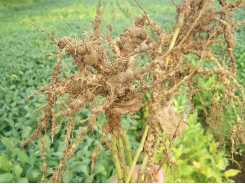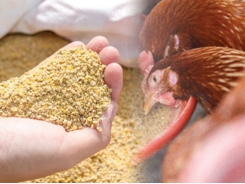Perinatal imprinting in poultry benefits performance

Mounting evidence shows that what chicks are fed around the time of hatching influences a bird’s performance and its nutrient requirement in later life.
The emerging science of epigenetics and nutrigenomics could rewrite the book on the nutritional requirements of broilers, according to scientists speaking at the Alltech 28th annual international symposium.
Manipulating gene expression around the time of hatching—or even earlier at the breeder stage—can condition birds for specific tissue development and nutritional requirements later in life. This can avoid overfeeding of certain nutrients and bring significant economic savings.
Dr. Peter Ferket, professor and extension poultry nutritionist at North Carolina State University, has spent around 12 years studying the effect of in ovo feeding. He said the new science will allow animals to be programmed for specific desired traits and tissue development. Nutrition during the perinatal stage (three days before and three days after hatching) can program how and when genes are expressed and thereby influence performance.
In ovo feeding is the administration of highly digestible nutrients into the amnion of embryos.
“We are now starting to understand how genes can be switched on and off,” he said. By exposing tissue during this critical stage of development to an adverse stimulus, it is possible to change the way a gene is expressed without changing the underlying DNA. The gene is then programmed and becomes an imprint for later life.
“If we can target and supplement the very first meal, the amnion fluid, we can manipulate gene expression and leave a nutritional signal that can influence the development of that animal,” he said.
“We already know that in ovo feeding can enhance tolerance to immunological stress, environment stress, oxidative stress, and bring about improved energy utilization. We can even change feeding patterns and how an animal eats.
“We are in a position to change the bird’s nutritional requirements and even rewrite the book,” he said.
Benefits of in ovo feeding:
- Improved chick quality
- Increased glycogen reserves
- Advanced gut development
- Improved skeletal health
- Advanced muscle growth
- Increased body weight gain (2 percent to 3 percent)
- Improved feed conversion
- Enhanced immune function
Higher poultry liveweight
Ferket has also shown that feeding a nutritionally programmed diet for the first 90 hours after hatching conditions, or imprints, the birds, which leads to better feed conversion and liveweight gain.
“We fed a typical corn-soy diet which was conditioned in key nutrients for the first 96 hours after hatching,” he said.
“Even after five days there is an improvement in liveweight. This carries through to 21 days, 42 days and 60 days. We also see that the feed conversion of broilers improves by programmed nutrition.”
Less shrinkage
Targeting metabolic keys to economically important traits such as efficacy of nutrient utilization or muscle development is the goal.
For example, “If we time in ovo feeding to myoplast development we can influence the development of muscle fibers,” said Ferket. He has been able to time in ovo feeding to boost the second and third wave of satellite cell development, resulting in heavier muscle development (see Table 1).
Bearing in mind that in the U.S. 50 percent of food is consumed as fast food or ready prepared to take home, shrinkage and cooking losses are a big concern.
“People who prepare food are interested in shrinkage and we see a significant drop in cooking losses with programmed feeding,” he said.
“Also, diets programmed to enhance anti-oxidative properties had a significant improvement on shelf-life and led to better flavor characteristics.”
Saving nutrients with epigenetics
Nutritional requirements can also be programmed by epigenetics and thereby avoid wasteful overfeeding of nutrients later.
Dr. Roselina Angel, associate professor at Maryland University, department of animal and avian sciences, has already shown that neonatal conditioning can elicit a change in an animal’s ability to utilize specific nutrients. Her work on phosphorous clearly demonstrates the potential of nutrigenomics and the epigenetic changes around hatching, which allows birds to better utilize nutrients in later life.
Timing is critical
Angel presented details of her research in which birds were challenged to a diet deficient in phosphorous (0.25 percent) and calcium (0.6 percent) for the first 90 hours. They were then fed a diet that exceeded nutritional requirements until 22 days of age. From 22 to 38 days of age, the diet was also deficient in phosphorous (0.11 percent) and calcium (0.4 percent). At the end of the trial, there was no significant difference in body weight between trial and control groups although, unfortunately, bone ash, a measurement of skeletal strength, was less.
“If we look at gene expression of the sodium phosphate co-transporter, which is responsible for phosphorous absorption at 90 hours, we see a three-fold increase in the conditioned birds. At 38 days we saw a 2.5 to 2.7 fold increase in the gene expression.
“However, we don’t want to see this negative impact on bone ash so we need to accurately determine the optimum timing of the challenge. We felt we started on the deficient diet too early,” she said.
Angel and her team will perform more experiments to find the critical point for conditioning and make the timing of the challenge as short as possible before the theory can be commercially implemented.
Savings on phosphorous
“There is clearly potential for genetic changes in terms of phosphorous. Based on our experiments I calculate I can reduce available phosphorous by 28 percent for each bird (just by changing the diet for 90 hours at early stage of life). This equates to 3.9 grams per bird (for a 2.2 kg/5.5 lb bird), which, in addition to significant cost savings, has a positive impact on the environment,” she said.
“This is not just an improvement in how we feed animals, this is a leap. Nutrigenomics is one of the tools with the most promise.
“We have seen in humans that gene expression can be transferred from one generation to another. This has not yet been explored in poultry, but the greatest potential is if we can imprint at the breeding stage so that chicks will be already conditioned for the future.”
Có thể bạn quan tâm
Phần mềm

Phối trộn thức ăn chăn nuôi

Pha dung dịch thủy canh

Định mức cho tôm ăn

Phối trộn phân bón NPK

Xác định tỷ lệ tôm sống

Chuyển đổi đơn vị phân bón

Xác định công suất sục khí

Chuyển đổi đơn vị tôm

Tính diện tích nhà kính

Tính thể tích ao hồ




 Brazilian ginseng may boost poultry feed efficiency, egg…
Brazilian ginseng may boost poultry feed efficiency, egg…  Ducks require more choline than broilers
Ducks require more choline than broilers